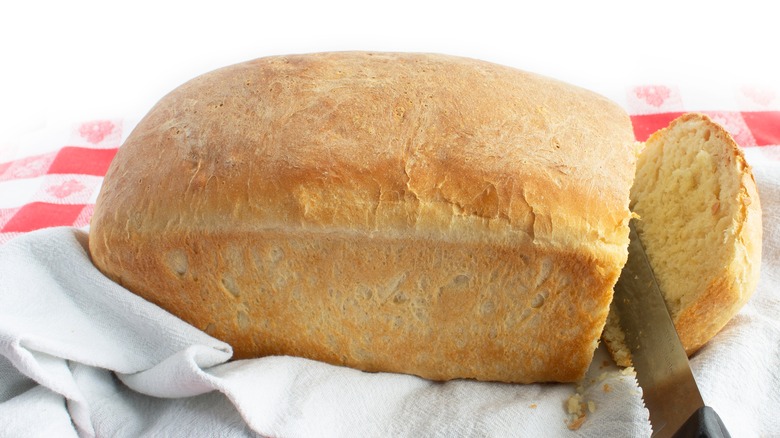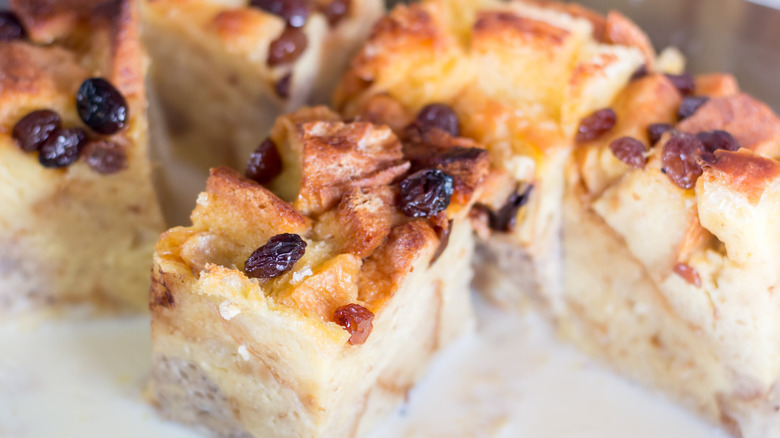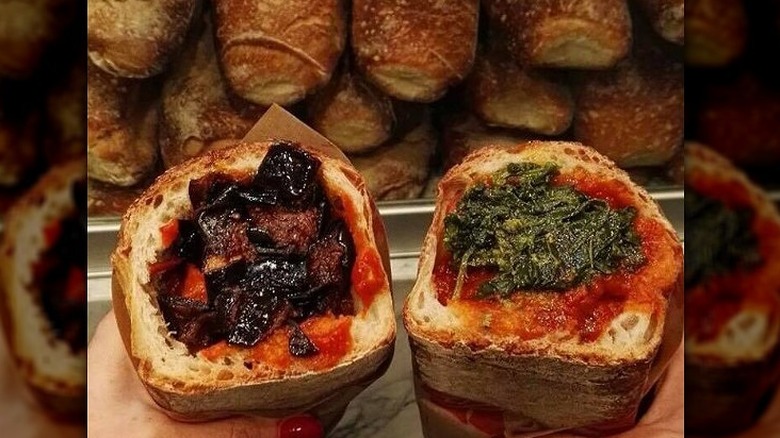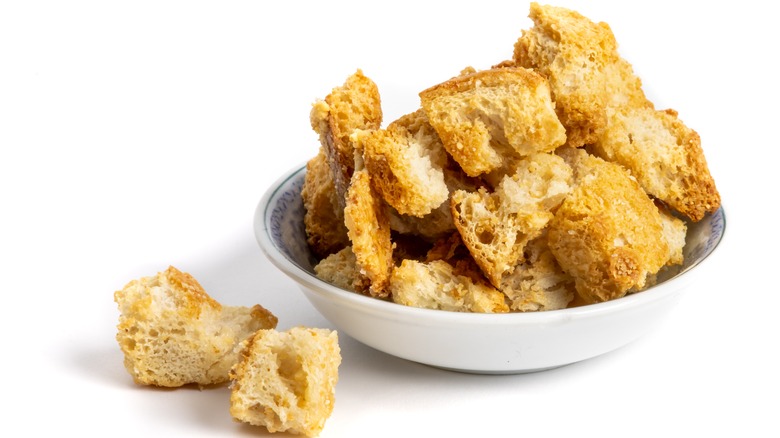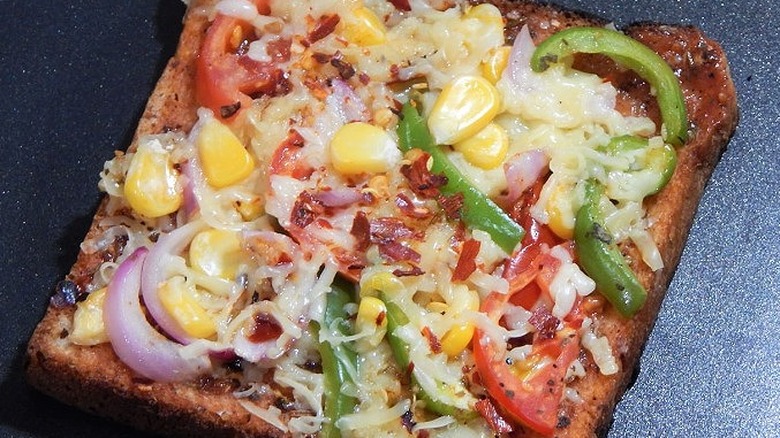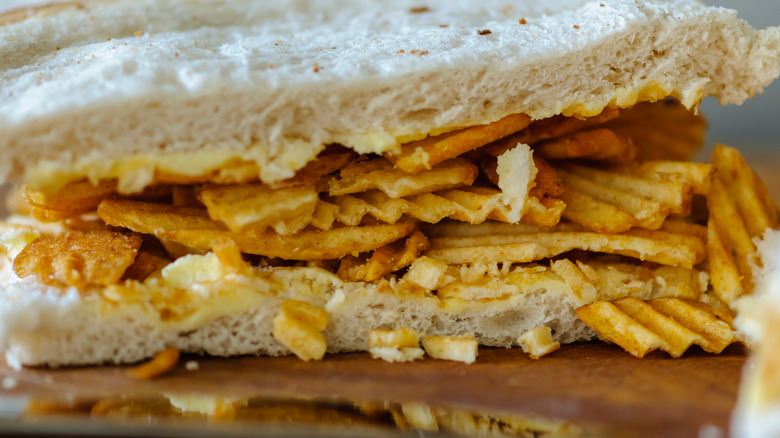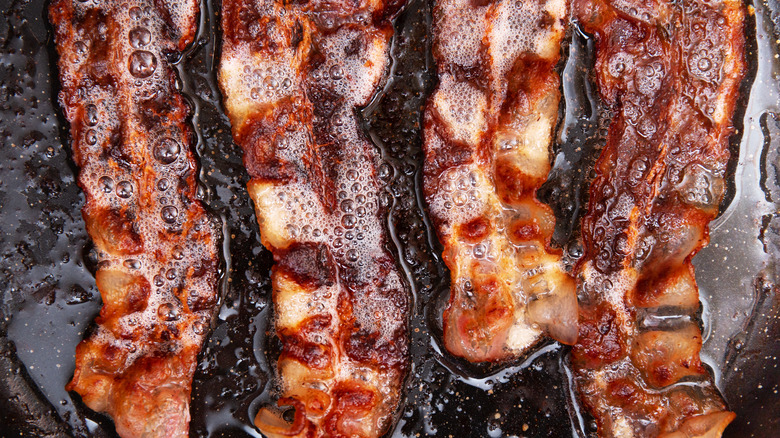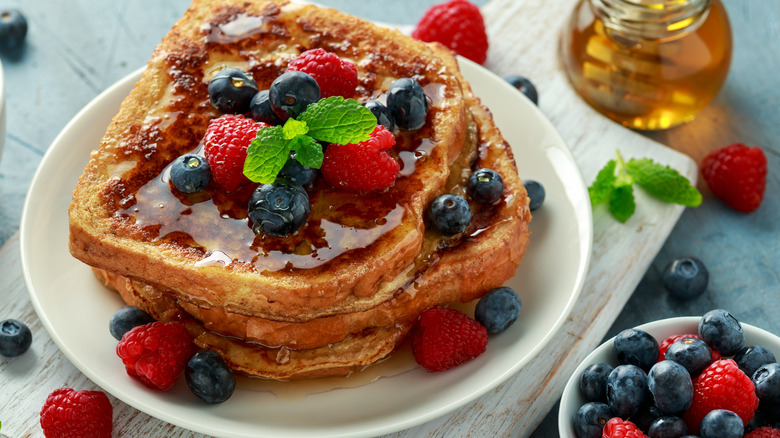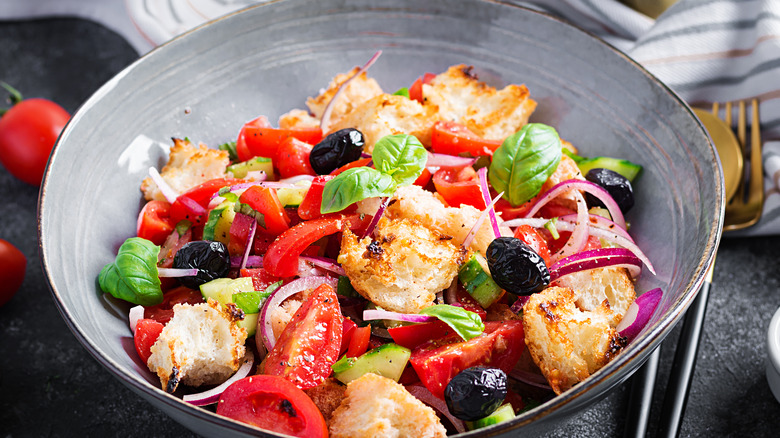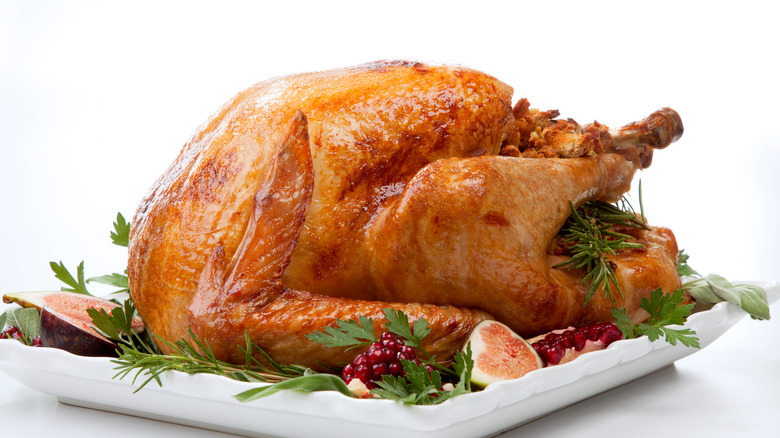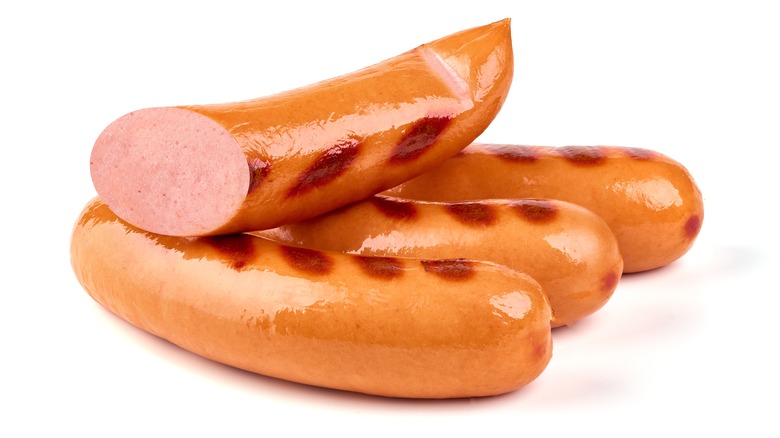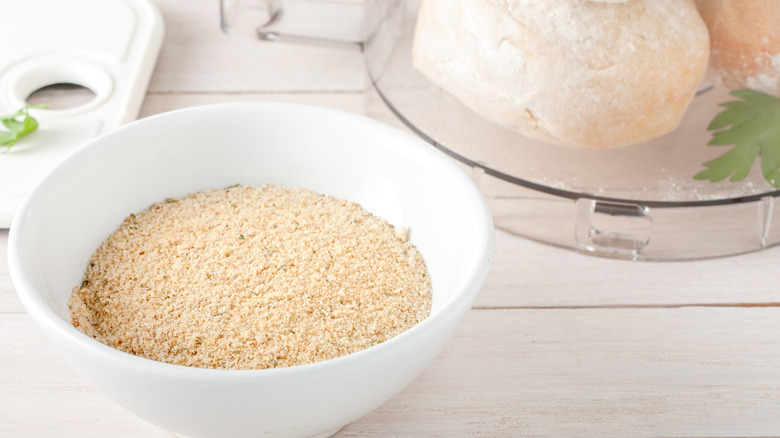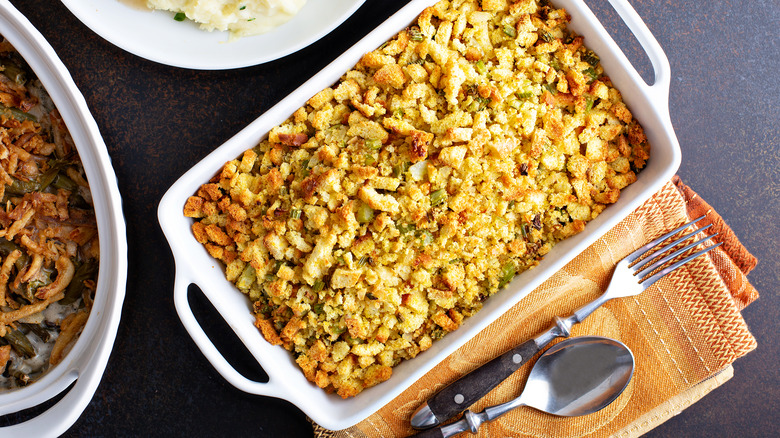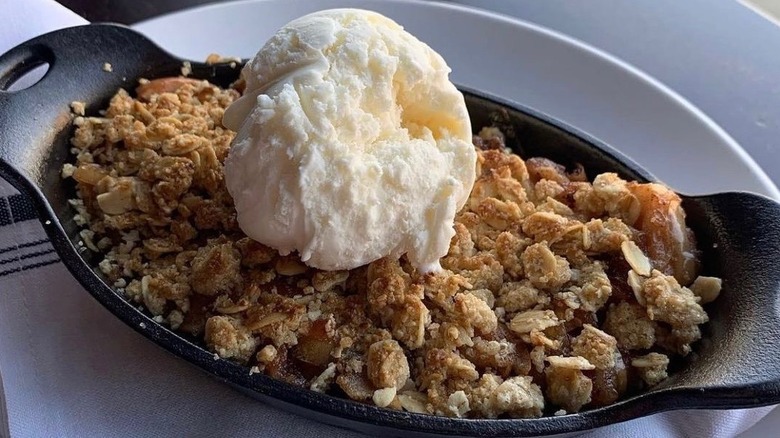15 Creative Ways To Use The Heel Of Your Bread
"Crust," "butt," or "skalk," whatever you want to call it, we're talking about the same thing. According to an article in The Insider, about 36.7% of users who responded to a Reddit poll called the end slices on bread the "heel." Southern Living notes that many people call this part of the bread "bird bread" because it is rarely used in the kitchen, rather just thrown out for the birds and other critters on the front lawn.
So if the end of the bread is so useless, why do bread companies still keep it on the loaf? According to Yummy, the heel of the bread is important because the piece keeps moisture from escaping from the bread and causing premature staleness. So these tiny heels are vital for the texture of the rest of the bread. The question then becomes, "what can you do with those pesky bread heels?" If you hate eating bread heels in a sandwich, there are several creative ways to use up the heels that don't involve tossing the pieces out to the birds.
Toss with custard for bread pudding
Bread pudding recipes are one of the simplest ways to use up old, discarded bread. Since the recipe requires an entire loaf of bread (and each bread only has two heels), you will need to freeze and store bread heels until you're ready to make bread pudding. You can store bread in an air-tight container in the freezer for up to a few months; do not store bread in the refrigerator if you want to prevent the slices from drying out.
You'll want to be sure to shred the bread pieces until it is almost unrecognizable. Keeping the bread soggy and supple with the custard is a vital component of the perfect bread pudding. We recommend serving bread pudding for dessert with a healthy scoop of ice cream or a drizzle of fresh cream. You can also substitute the traditional raisins in this recipe for chocolate chips if craving added decadence.
Make a cuzzetiello
The cuzzetiello is a delight in Naples that roughly translates to "bread bowl sandwiches." The Neapolitans use bread heels as an envelope for fillings ranging from eggplant parmesan to ragu. These street-friendly sandwiches are the walking taco of Italy; you can order almost every filling, from a sweet Nutella spread to a savory vegan roasted vegetable filling. Although the Neapolitans typically use a crusted Italian bread called a pane cafone, according to La Cucina Italiana. This rustic homemade loaf has the perfect crusty exterior to carry the weight of the filling and a soft pillowy interior that can easily be manipulated to press and stuff with your favorite fillings.
Visit Naples notes the most important part about making and eating a cuzzetiello is not to be afraid to get dirty. The filling will likely overflow out of the bread and get everywhere, but that's just part of the fun of making this sandwich.
Soften brown sugar
Diving into a bag of brown sugar and finding clumps is nothing but pure disappointment. Put the heels of your bread to work by placing the slices into an opened bag as a way to keep brown sugar soft. Brown sugar dries out because of a lack of moisture in the bag. The sugar molecules utilize the moisture in the bread to soften and remain super soft and easy to scoop for your next batch of cookies.
You should only leave the bread in the bag of sugar for one to two days before removing it. The moisture in the bag can cause the bread to mold; therefore, taking it out with just enough time to spare is important. Domino Sugar notes that although the shelf life of brown sugar is technically indefinite, maximum freshness really lasts only two years if stored correctly. Regardless, you should first try to store opened containers in an airtight compartment to prevent clumping in the first place, and make sure to have your bread heels handy.
Make croutons for a salad
Although it may not be the most unconventional way to use leftover pieces of bread, creating croutons from bread heels is one of the most classic and utilitarian food waste reduction methods. There are several different methods you can use to make croutons at home. Toast bread pieces in a skillet with ghee, butter, or high-smoke point oil until warm and toasty on all sides. For croutons with a longer life span, you'll want to place bread pieces on a baking sheet and bake for 10 to 15 minutes at 350 F. While an even cut on each side of the bread is preferable, you can also tear the bread into uniform pieces.
We also recommend adding a few of your favorite seasonings. Salt and pepper are both standard options, but try adventuring into the realm of garlic powder, onion powder, and Italian seasoning to provide even more flavor to your croutons. You can also add a layer of Asiago or parmesan cheese to your croutons for the perfect garnish on a wintery broccoli cheddar soup.
Bake bread pizza
Although this bread pizza recipe may be reminiscent of a night in a dorm room or snacks with your childhood babysitter, bread pizza deserves to be celebrated as a delicious way to use up leftover bread heels. You can coat the heel of the bread in your favorite pizza sauce, a sprinkle of shredded mozzarella, and your favorite toppings like pepperoni, sausage, or basil. There's no wrong topping to put on your easy at-home pizza!
If you're looking to create more flavorful pizza at home, try drizzling high-quality olive oil over the bread to improve the color and crisp up the edges. You can also add a sprinkle of garlic salt, parmesan, or herbs for a better flavor. And though the microwave is obviously the easiest way to melt the cheese and sauce on the bread, you should try placing the bread into the oven for an even crispier crust.
Flip the bread inward to make a sandwich
This is a little-known trick from summer camps around the country. If kids are hesitant to eat the heel of the bread when it's turned outwards, why not just flip the piece so you wouldn't know the difference? Kids won't have the time of day to notice what's on the inside of the sandwich, especially when it's filled with a Nutella spread or made into a fluffer-nutter sandwich packed full of creamy peanut butter and whipped marshmallow topping.
There are a few simple tricks to making your sandwich even better. We recommend improving your sandwich by placing it in the oven for 10 minutes at 250 F to heat up and melt the fillings. This tip is especially important when working with the heel of the bread because heating the bread gets super toasty, crisp, and satisfying when you take a bite into the sandwich.
Soak up the grease from bacon or hamburgers
Reddit users are nothing short of inventive, especially when considering that some users suggest employing leftover bread heels to soak up the remaining grease from cooking bacon or burgers on a skillet. The bread acts like a big sponge when it comes to the remaining fat in the pan. This prevents you from dumping the oil straight down the drain and causing a slick wad of grease that can eventually solidify in your sink pipes.
While you can eat the bread heels after soaking in bacon grease (just like in an episode of Trailer Park Boys), there are some health risks of eating the bread heel after you've soaked it in grease. According to PCRM, excessive consumption of saturated fats causes significant health complications. These include, but aren't limited to, a higher risk of stroke, heart disease, and potentially certain kinds of cancer (via the Harvard School of Public Health).
Use your bread heel for french toast
What makes excellent French toast? The crusty pieces, of course! That's why we not only recommend using the bread heels for the perfect French toast recipe but also keeping a toaster handy. Before soaking your french toast, you should pop all of your French toast slices (including the heels) into the toaster. You'll want to dry out the toast while being careful not to brown the toast too much.
Warming and drying are important to reducing the moisture content of the bread; it's similar to using day-old baked goods to make your French toast. This, in turn, causes the bread to soak up the custard mixture and prevents the bread from getting soggy once it's cooked. Dress up your French toast by adding spices, warm maple syrup, or a little bit of whipped cream. It's clear that there isn't a wrong way to eat French toast!
Make panzanella salad
Tomato panzanella salad is a perfect way to use old bread or bread heels. The bread soaks up the tomato juice and red wine vinegar for a flavorful, fresh salad perfect on a summer day. We recommend using heirloom tomatoes for a panzanella salad because the exquisite flavor and color of these tomatoes are unlike other standard grocery store globe tomatoes. Plus, a generous topping of fresh garden herbs like parsley and basil will elevate your salad's flavor and freshness.
Ciabatta is the preferred bread type for the panzanella salad because it has a soft interior and crusty exterior; this texture allows the bread to hold up well to the moisture in the rest of the salad. According to the travel site Experi, the traditional Italian salad is not made with toasted bread pieces but rather stale chunks that become rehydrated when soaked in the liquid. If you use the bread heels, you'll want to leave the ends on the counter for a few days to promote that normally undesirable quality.
Place bread heels under the turkey to soak up liquid
Flipping and cooking a turkey on its breast rather than its back results in a more succulent, juicy Thanksgiving turkey. And according to recommendations from Everyday Food, you can use buttered slices of bread to support the fragile turkey breast and soak up the delicious juices pooling from the bird. The bread replaces the rack on the bottom of the pan when you're cooking your turkey. And the best part is at the end of the cooking process, when you can slice up the bread and serve it with the turkey!
Although the original trick suggested using an entire loaf of bread, you can use several bread heels to line the pan. You'll want to use enough pieces to line the entire pan and enough butter to prevent the turkey skin from sticking to the bread. "What the butter will do is it will melt down in the pan," Thomas says, " and give you wonderful basting juices so that your turkey will be beautiful and brown."
Use it as a bun for a hot dog
The heel of the bread already resembles a hot bun, so why not use up this often overlooked piece to encase your favorite summer BBQ meat? For such a simple staple, there are a lot of common mistakes people make with hot dogs, but among the ones easiest to avoid is toasting the bun. And, the best way to toast a hot dog bun is on a stovetop skillet. The heat is more even than a grill, and adding a swipe of olive oil before toasting the buns will enhance the flavor and toastiness of the bread.
You can keep your bread heels in the freezer until you're ready to thaw the package and enjoy. We recommend using heels of sandwich bread instead of a crusty ciabatta or baguette for a hot dog bun to avoid distracting from the texture of the hot dog (and whatever other toppings your heart desires). If you use the heels of the bread instead of buying hot dog buns, you won't have to worry about purchasing a specific number, or buying a pack of bread with only one primary purpose.
Pulse in a food processor to make breadcrumbs
If you're dead-set on breaking up bread heels into a completely new food, breadcrumbs are one of the easiest options. You can make homemade bread crumbs in a food processor or by hand, but the most important part is making sure your bread is slightly stale. If you want to speed up this process, place the bread on the counter for a few days to let it dry out. If you plan to use a food processor to pulse your breadcrumbs, you'll want to move in small batches to ensure all the pieces are equally-sized pieces. You can make larger chunks or smaller, dustier pieces.
If you plan to crunch the bread by hand, making sure the bread is dry is the pivotal first step. Use a rolling pin or a frying pan to break up the pieces inside of a resealable plastic bag. Add your favorite Italian spices and store your new ingredient in an air-tight container for no more than two weeks.
Make your own stuffing
It may not be an original way to use the rest of your bread heels, but homemade stuffing is the perfect companion for everything from poultry to pork. The downside to making your own stuffing is the sheer amount of bread you need; our country bread stuffing recipe uses two pounds (close to 20 cups) of bread. Unless you plan on downsizing the entire recipe, you can store bread on a table or shelf in your kitchen.
Crumbly stuffing is easy to avoid when you keep the bread as dry as possible and cut back on the mix-ins, such as things like vegetables and meats. The best ratio of bread to additions is around 2-to-1; this will allow the binding liquid to do its job and keep the stuffing from falling apart everywhere. You can flavor your stuffing with any of your favorite seasonings, spices, or broths — as well as the satisfaction of knowing you did it with something that is normally food waste.
Use as a spoon rest for pasta and sauce
If you're cooking a homemade pasta sauce or stirring up a warm winter chili, you've probably spent a split second or two waving around your utensils looking for the cleanest place to place your spoon. While you can invest money into a fancy spoon holder from Williams Sonoma or purchase a spoon with a built-in rest, you can just as easily (and frugally) use a piece of bread heel to rest the wide part of your spoon on. Not only is the clean-up for this method easy, but you can also enjoy a little bit of sauce on your bread heel once you're finished cooking.
According to La Cucina Italiana, the Italian word for soaking up leftover sauce with bread is called scarpetta. The word roughly translates to "little shoe" because the bread, like a shoe, drags up all the sauce and liquid on the plate (or counter). And don't worry — we won't tell anyone if you eat the heel of the bread after you finish cooking.
Make an apple brown Betty
According to What's Cooking America, the apple brown Betty was a popular colonial-era dessert made with layers of apples and buttered breadcrumbs. The dessert resembles a cobbler, but with chunks of bread (like a bread pudding) instead of a thin streusel. According to Dessert Now Dinner Later, the apple brown Betty may have been initially layered to collect the apple drippings from the upper coatings of the dessert. The brown Betty is traditionally served with a generous douse of cream and was thought to be originally inspired by the French Charlotte Aux Pommes (Apple Charlotte). The Apple Charlotte is made from layers of pulverized breadcrumbs rather than shredded bread slices.
You can alter the recipe to fit whatever bread heels you have left. For example, ciabatta or Italian loaves tend to be denser than pieces of sliced bread torn into tiny pieces. Depending on the size of the bake you plan to make, you may have to save up your bread heels for a few months in preparation.
